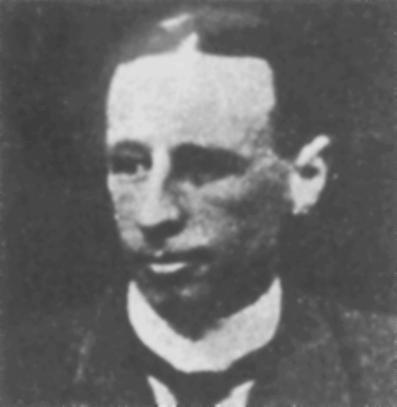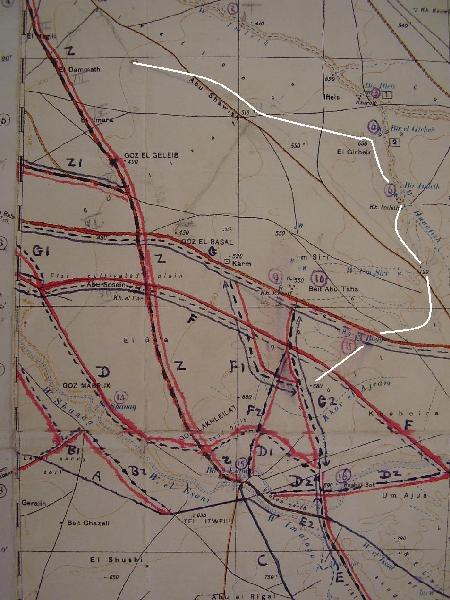Topic: BatzP - El Buggar
The Battle of El Buggar Ridge
Palestine, 27 October 1917
Outline

The Battle of El Buggar Ridge took place on 27 October 1917. It began as a reconnaissance in force by the Ottoman forces to test the resolve of the Allied defensive perimeter around the newly opened supply station of Karm. It ended in a battle which progressively drew in more Allied forces until they were able to eject the Ottoman forces from the trenches on El Buggar Ridge.
With the completion of the rail link and water pipe from Tel el Fara to Karm, the final logistic preparations for the oncoming battle at Beersheba had been completed. To protect this vital supply depot from artillery harassment from the Ottoman forces at Abu Hareira, Henry Chauvel, the General Officer in Command of the Desert Mounted Corps decided to transform a ring of temporary outposts into a permanent defensive line. To that effect, on 22 October, he ordered the seizure of the outpost line and conversion into a permanent defensive line. The line traversed west to east from "Two Tree Farm", Point 510, Point 550, Point 630 and then south to Point 720 and crossing the Beersheba Road at El Buggar.
El Buggar Ridge defensive line.
[Click on map for larger version.]
The Allied Defence Perimeter consisted of minor trench works built after the 8th Mounted Brigade took possession of the outpost line when they relieved the Australian 4th Light Horse Brigade. By 27 October, the line was still disorganised with only weak redoubts constructed at Points 720 and 630.
For the Ottoman forces, the occupation of Karm created a major point of supply and water for the Allied troops in the immediate area. The placement of the station at Karm placed under threat the defensive positions known as the Hureira Redoubt and Rushdie System which formed a powerful bulwark against any Allied action. Karm Station pointed right to the heart of this system.

Karm Station today
[Photograph by Gal Shaine.]
To overcome this, General Erich von Falkenhayn, the Commander of the Yildirim Group, proposed a two phase attack. Firstly the plan called for a reconnaissance in force from Beersheba for 27 October which was to be followed by an all out attack launched by the 8th Army from Hureira, ironically scheduled to occur on the morning of 31 October 1917, the day when the Battle of Beersheba began.
At four o'clock on the morning of 27 October, the outpost at El Buggar was fired upon by a Troop of Ottoman cavalry. An hour later the attack developed across a wide front employing some 2,000 Ottoman infantry, 1,200 cavalry, supported by a three batteries of Mountain Guns, some twelve guns in all. The advancing Ottoman forces debouched from the Kauwukah defensive system to attack the Allied forces occupying the ridge.
The initial battle occurred around Point 630. The Ottoman infantry, the 125th Infantry Regiment, worked its way around both flanks of the redoubt and brought heavy machine-gun and artillery fire to bear on the squadron holding it. Flying overhead on the day, the Royal Flying Corps estimated that a force of about 2,000 men had attacked the garrison, which was at that time cut off from any support.
In response, the 1/1 City of London Yeomanry sent a squadron to reinforce the surrounded 1/1 County of London Yeomanry squadron at Point 630. The relieving force was held up by an effective machine gun barrage and after several attempts at entering the redoubt, was compelled to withdraw. In further assistance, two squadrons from the 10th Light Horse Regiment were despatched but they too were held up. Despite these set backs, the garrison held out in a support trench close behind the crest of El Buggar Ridge. Here they repeatedly fought off Ottoman attempts to rush them. The garrison held out until relieved later that evening.
In contrast, the assault on Point 720 against "B" Squadron, 1/1 County of London Yeomanry was far more determined. The attacking force was composed of 1,200 men from the Ottoman 3rd Cavalry Division supported by an under-strength battalion from the 27th Infantry Division. Following a heavy volume of shell and machine gun fire the Ottoman force launched two charges which were beaten off. After regrouping, a third charge pressed home the attack and gained possession of the hill. "B" Squadron had held out for six hours. Except for three men, all the defenders were either killed or wounded.
In support of the beleaguered garrison, at noon, the 9th Light Horse Regiment despatched two squadrons to relieve the 1/1 County of London Yeomanry at Point 720. By 3pm, two infantry brigades of the 53rd Division were moving towards the ridge. A officer's patrol from the 9th Light Horse Regiment at 7 pm established that the Ottoman forces had withdrawn from their positions on Point 720 which allowed the Allied forces to re-occupy El Buggar Ridge without further casualties. That night 229th Infantry Brigade took over the defensive perimeter and re-established Allied control over the area.
The recapture of El Buggar Ridge had two strategic effects.
In the first instance it gave the Ottoman forces the wrong message as to where the projected Allied offensive might strike. Subsequent Turkish air reconnaissance indicated that nothing had changed with the Allied forces dispositions. Falkenhayn drew the inference that he needed to act first with a pre-emptive strike at the heart of the Allied logistic system and thus set in motion the planned attack by the 8th Army scheduled for 31 October, and by doing so, inadvertently unbalanced the Ottoman defensive system.
By diverting the attention of the Ottoman forces, Allenby was able to direct the movement of some 40,000 men from two corps (the XX Corps and the Desert Mounted Corps) to the Beersheba perimeter in complete secrecy. This was possibly one of the most brilliant pieces of staff work in the Allied forces at that time. When the two corps debouched from the hinterland onto the Beersheba defences, the Ottoman forces were taken by complete surprise.

References cited:
AWM 253, 455-5-705, 3rd Light Horse Brigade Routine Orders, 1917.Falls, Cyril, Palestine, Official British War History, (London 1929).
Massey, W.T., How Jerusalem was Won, (London 1918).
Major General Hüseyin Hüsnü Emir (Erkilet), Yildirim, (Ankara 1922).
Olden, ACN, The Westralian Cavalry in the War - 10th Light Horse AIF, (Melbourne 1921)
Further Reading:
The Battle of El Buqqar (Buggar) Ridge, Palestine, 27 October 1917
The Third Battle of Gaza, Palestine, 26 October 1917 - 2 January 1918
The Third Battle of Gaza, Palestine, Z - 4, 27 October 1917, Roll of Honour
Battles where Australians fought, 1899-1920
Citation: The Battle of El Buqqar (Buggar) Ridge, Palestine, 27 October 1917, Outline




